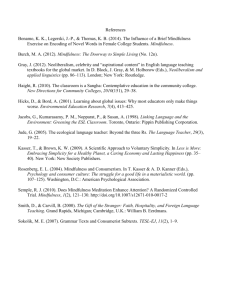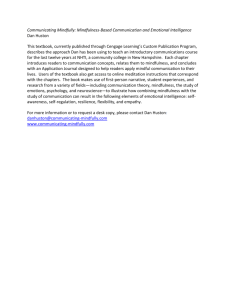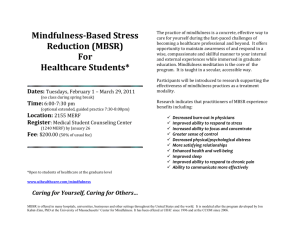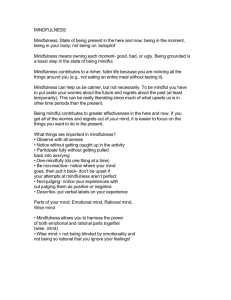Military Psychology: Situation Awareness
advertisement
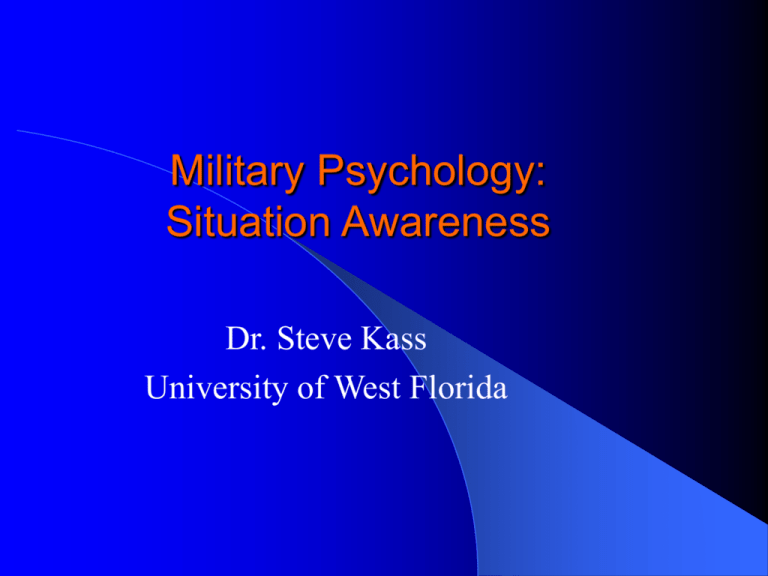
Military Psychology: Situation Awareness Dr. Steve Kass University of West Florida Situation Awareness Definitions Is SA a construct, phenomenon, process, or product? Situation Awareness -“The perception of the elements in the environment within a volume of time and space, the comprehension of their meaning, and the projection of their status in the near future (Endsley, 1988) -“Skilled behavior that encompasses the processes by which task-relevant information is extracted, integrated, assessed, and acted upon” (Kass, Herschler, & Companion, 1991). -“Continuous extraction of environmental information, integration of this information with previous knowledge to form a coherent mental picture, and the use of that picture in directing further perception and anticipating future events” (Dominguez, 1994). Levels of SA Levels of SA 1 – Awareness of information 2 – Comprehension of its meaning 3 – Projection of future status Situation Awareness Components Components of SA 1. Spatial Awareness – Loss of SA – GLOC, spatial disorientation System Awareness 2. – Loss of SA – insufficient scan, distraction, lack of checklist Task Awareness 3. – Loss of SA – Competing tasks, poor task management, lack of vigilance Rasmussen’s Skill-, Rule-, and Knowledge-based performance model High Novice Analytic Intuitive Low Expert Automatic Situation Awareness Model Task/System Factors •System Capability •Interface Design •Stress & Workload •Complexity •Automation Feedback SITUATION AWARENESS State of the Environment Perception of elements in Current Situation Comprehension of current Situation Level 1 Level 2 Projection of Future Status Performance DECISION Of Actions Level 3 Individual Factors •Goals & Objectives •Preconceptions (Expectations) Information Processing Mechanisms Long Term Memory Stores •Abilities •Experience •Training Automaticity Measuring SA Typical Constructs measured in trying to assess SA Mental Models Pattern Recognition Attention SA Working Memory Workload Performance Factors Affecting Loss of Situation Awareness • Attention • attentional demands of controlled processes (k-based performance) • Pattern Recognition • inability to perceive pattern of cues (recognition-primed DM) • Workload • tasks too demanding or too many at once • Mental models • inadequate understanding of system or state • Working Memory • failure to adequately “chunk” information Attention Narrowing of attention under stress (high workload) adversely impacts SA Examples: • Commercial plane crashes in the Everglades when aircrew becomes fixated on a warning light while the plane slowly descends into the ground. • Outfielder for the Mets tosses ball to a fan after making the second out while runner on base easily scores. Pattern Recognition Perceptual Recognition – comparing incoming stimulus information with stored knowledge in order to categorize the information. QB reading pattern of defense Workload Workload often used as a surrogate measure for SA. – Note reference to workload in SA measures such as CLSA and NASA TLX Mental Models Mental Models – how people mentally represent the task they are performing Represent & organize info by interconnected chunks (schema) Experts organize schemata into larger, more meaningful/ easy to access chunks. Novices may not see all relevant connections Use mnemonic devices to help novices organize and retrieve info Working Memory Ability to “chunk” information may be what distinguishes expert decision-making from that of novices – Magical number 7 IBMUSANBCGREUWF Experts recall larger chunks of information (more chess pieces) when they recognize a meaningful pattern. When the pattern is random, performance same as novices. Commercial pilots may have to monitor and react to up to 400 instruments and gauges. 747 cockpit Types of SA Measures Subjective Ratings – E.g., China Lake SA Rating Scale, Situation Awareness Rating Technique, SA Supervisory Rating Form Performance-based – Ability to regain control from dangerous attitudes Query – SAGAT Situation Awareness Rating Technique Low 1 Instability of Situation Variability of Situation Complexity of Situation Arousal Spare Mental Capacity Concentration Division of Attention Information Quantity Information Quality Familiarity 2 3 4 5 6 High 7 Performance-Based Measures of SA Performance-based SA measures – ex: Ability to correct from unusual attitude (in simulator) Query-based Measures of SA SAGAT – Situation Awareness Global Assessment Technique – Halt simulation – Black-out displays – Randomly selected questions – Pilot recall Problem of SA Measurement SA is Difficult to measure: Self-report measures - Only aware of what you are aware of Performance-based measures – Intrusive, measure affects performance Query-based – might only tap memory 6 O’Clock Problem – Can not assess your awareness of the things you are not aware of. Experiment: Driver Situation Awareness as a factor of Experience Level & Cell Phone Usage Kass, Cole, & Stanny, 2007 9 4 8 3.5 3 6 Novice Experienced 5 Turns Missed Total SA Questions Correct 7 4 3 2.5 Novice Experienced 2 1.5 1 2 0.5 1 0 No Cell Phone 0 No Cell Phone Cell Phone Condition Cell Phone Condition Experiment: Driver Situation Awareness as a factor of Experience Level & Cell Phone Usage Driving Infractions 14 Total Driving Errors 12 Road Excursions 10 Pedestrians Struck 8 Stop Signs Missed Centerline Crossing 6 Collisions 4 Speed Exceeded 2 0 Novice - No Cell Experienced - No Cell Novice - w/ Cell Phone Experienced w/ Cell Phone Kass, Cole, & Stanny, 2007 Improving Situation Awareness Cue Filtering – eliminate irrelevant cues (clutter) that interfere with accurate assessment of situation Augmented Displays – displays that highlight or overlay actual information to make it more salient Spatial Organization – arranging displays to capitalize on spatial relationships (e.g., pop-out effect) Automate Status Updates – as the environment changes the system should warn the user of change Train Users to Improve Attention? Cue Filtering for Improving SA Removal of clutter (irrelevant cues) in training allows learner to identify relevant cues better – Real-world “clutter” can then be gradually phased back into training. Spatial Organization in Display Design for Improving SA Display design capitalizing on spatial relationships – “Pop-out effect” Tactile Situation Awareness System Tactile stimulation used to prevent spatial disorientation Tactile cues can provide status updates regardless of where attention is currently focused Human factors application of tactile research Tactile Situation Awareness System (TSAS) Map surrounding space to the torso tactually Intuitive in three dimensions Non-visual Non-competing Continuous source Utilizes “seat of the pants” sense TSAS Performance Means RMSE TSAS Off No Secondary Task Yes On M = 4.55 SD = 3.55 M = 4.33 SD = 3.48 M = 7.24 SD = 3.73 M = 5.75 SD = 3.06 •RMSE for helicopter hover under 20/200 viewing conditions (White out) •Secondary task was a simple arithmetic task Augmented Reality Displays Augmented Displays - display that improves upon reality by superimposing info over actual environment ex: thermal imaging color codes objects by temperature HUDs superimpose display information on the PVA Mindfulness Training and SA? • Few, if any, attempts to improve SA have focused on the human component of the human-machine systems • Research idea: mindfulness training to increase ability to concentrate and improve attention Experiment: Mindfulness & SA Impact of mindfulness training on situation awareness while driving Psychology Class • Control group – Experimental Psychology Class SA questions correct (out of 9) • Mindfulness – Moving and sharpening the focus of awareness within the field of consciousness. • Concentration – Actively maintaining one’s controlled focus of attention for designated periods of time • Mindfulness training – Buddhist 6 5 4 3 2 1 0 Mindfulness Training Control Group Experiment: Mindfulness & SA Impact of mindfulness training on situation awareness 1. while 2. driving 3. 4. 5. 6. 7. 1. Situation Awareness 2. Mindfulness 3. Concentration 4. Stopping violations 5. Speeding Violations 6. Vehicle Collisions 7. Pedestrian Collisions -- .80** .61* -.65* -.14 -.11 -.01 -- .69** -.49 -.07 .10 -.61* -- -.40 -.08 .12 -.20 -- .13 .03 -.20 -- .01 -.07 -- -.04 -- * p < .05. **p < .01. SA Medical Training Gaba et al’s suggestions for training SA in medical applications 1. Provide practice scanning instruments and environment to maximize perception of cues from all relevant data streams 2. Provide explicit training in allocation of attention using low fidelity simulations, and multi-faceted training in high fidelity simulations 3. Provide enhanced training in situation assessment and on pattern matching of cues to known disease and fault conditions
